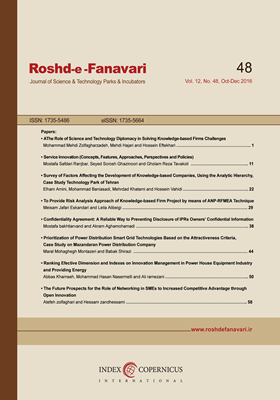The future Prospects for the Role of Networking in SME to increased Competitive Advantage through Open Innovation
Subject Areas : Technology ManagementAtefeh Zolfaghari 1 , Hesam Zand Hesami 2
1 -
2 -
Keywords: Networking Competitive Advantage Small and Medium-sized Enterprise Future Open Innovation,
Abstract :
Networking technology and innovation is the most important development strategies to enhance the competitiveness of enterprises in an increasingly competitive environment of today's world. Firms will be able to Identifying new technologies, customer needs through foresight, capture ideas and thereby contribute to the implementation and strengthening of open innovation. This article is a qualitative study that by studying the documents, databases and articles foresight, competitive advantage, and networking is formed and is integrated with content analysis and scenario. The network of small and medium-sized enterprises, open innovation process data play an important role. According to data collected in the process of networking in open innovation of small and medium, enterprises are playing an important role. This article examines the future prospects with Back casting to design a scenario has been discussed and the important role of small and medium enterprises contained within the networking. In this type of business due to the use of open innovation process, companies in the course of an idea to getting products to market, from other companies or organizations in the network will receive assistance and business ideas, technical knowledge, technology, and services, production and distribution of new methods to get new markets in the emerging network, in this way company will increase revenue and reduce costs. In the process of open innovation companies regularly selling ideas, knowledge, technology and services are networking with other companies, thereby increasing revenue and reducing company costs and ultimately achieve a competitive advantage for the firms.
1- حجازي و همكاران (1389)، ارزيابي تكنولوژي در شركتهاي كوچك و متوسط، انتشارات سازمان مديريت صنعتي.#
2- درستکار احمدی، ناهید؛ ملک اخلاق، اسماعیل؛ مهدیزاده، مهران (1393). ارائه مدلی برای تبیین تأثیر مدیریت راهبردی منابع بر مزیت رقابتی شرکتهای انبوهساز مسکن و ساختمان استان گیلان: بررسی نقش میانجی خلاقیت و نوآوری، فصلنامه علوم مدیریت ایران، مقاله 4، دوره 9، شماره 33، بهار 1393، صفحه 69-96.#
3- باقري، سيدكامران؛ نيلفروشان، هادي؛ رضاپور، مرتضي، رشتچي مريم (1388). رويكردي جديد به نقشه راه فناوري در فضاي نوآوري باز: مطالعه موردي فناوري غشا در پژوهشگاه صنعت نفت، سياست علم و فناوري بهار 1388; 2(1):92-82. #
4- جاويد، غزاله و باقرينژاد، جعفر (1391) ارتباط فرايند نوآوري باز و توانمندي جذب بنگاهها، رشد فناوري، سال هشتم، شماره 31، تابستان 91. #
5- طبائيان، سيدکمال؛ منطقي، منوچهر؛ بامداد صوفي، جهانيار؛ طباطبائيان، سيدحبيبالله (1390). بررسي ميزان حمايت شرايط زمينهاي ايران از اتخاذ رويکرد نوآوري باز، مطالعه موردي نظام نوآوري هوايي. بهبود مديريت، سال پنجم، - شماره 3،1390، صفحه 12-7.#
6- انصاري، رضا، (1391). همکاريهاي فناورانه: مفاهيم کليدي و عوامل موفقيت، رشد فناوري بهار 1391; 8(30):65-71.#
7- Cecd, D. & Lupke, C. (2003), Financing entrepreneurship in distressed areas, financial management, 25(3), pp.23-34, 2003. #
8- Guillo, Mario. (2013),”Futures, communication and social innovation: using participatory foresight and social media platforms as tools for evaluating images of the future among young people”, Eur J Futures Res (2013) 1:17#
9- Bell, W. (1998), making people responsible: the possible, the probable, and the preferable. Am Behav Sci 42(3):323– 339#
10- Kok, K., van Vliet, M., Bärlund, I., Dubel, A., & Sendzimir, J. (2011).”Combining participative backcasting and exploratory scenario development: experiences from the SCENES project”. Technological forecasting and social change, 78(5), pp.835-851.#
11- Zali, M., Schøtt, T., Kordnaeij, A., Najafian, M. (2011), Entrepreneurs' networks affecting innovation: Firms in Iran and Denmark. African #
12- Forret, M. L., & Dougherty, T. W. (2004), Networking behaviors and career outcomes: differences for men and women? Journal of Organizational Behavior, 25(3), 419-437.#
13- Wolff, H.-G., & Moser, K. (2009), Effects of Networking on Career Success. Journal of Applied Psychology, 94(1), 196-206.#
14- Keegan, Warren J. (1999) “Global Marketing Management”Prentice Hall, 1999#
15- Porter, K. (2000): Marketing Management, the Millennium Edition, New. Jersey: Prentice-Hall#
16- Lofsten, Hans. (2014), Product innovation processes and the trade-off between product innovation performance and business performance, European Journal of Innovation Management, Vol. 17 No. 1, pp. 61-84.#
17- Cheng, Jao-Hong., Chen, Mu-Chung., Huang, Chung-Ming. (2014), Assessing inter organizational innovation performance through relational governance and dynamic capabilities in supply chains, Supply Chain Management: An International Journal, 19/2, 173–186. #
18- Chong, A.Y.L., Chan, F.T.S., Ooi, K.B. and Sim, J.J. (2011),“Can Malaysian firms improve organizational /innovation performance via SCM?”, Industrial Management & Data Systems, Vol. 111 No. 3, pp. 410-431.#
19- Minh, Thai. Hjortsø, Carsten Nico. (2015) How Institutions Influence SME Innovation and Networking Practices: The Case of Vietnamese Agribusiness, Journal of Small Business ManagementVolume 53, Issue Supplement S1, pages 209–228, October 2015#
20- Brink, Tove. (2016), OVERNANCE OF INNOVATION AND GROWTH IN SME NETWORKS, Int. J. Innov. Mgt.,20, [23pages] DOI: http://dx.doi.org/10.1142/S1363919616500523#
21- Cardullo, M. (1999), ”Technological entrepreneurship: entrepreneurship formation, financing and growth”, research studies press, 23(5), pp. 13-29, 1999. 10. #


